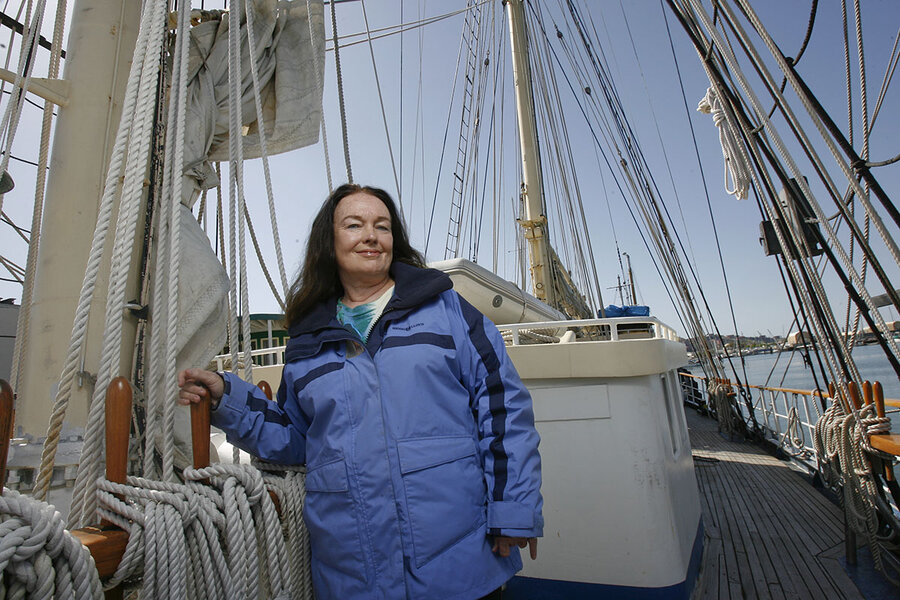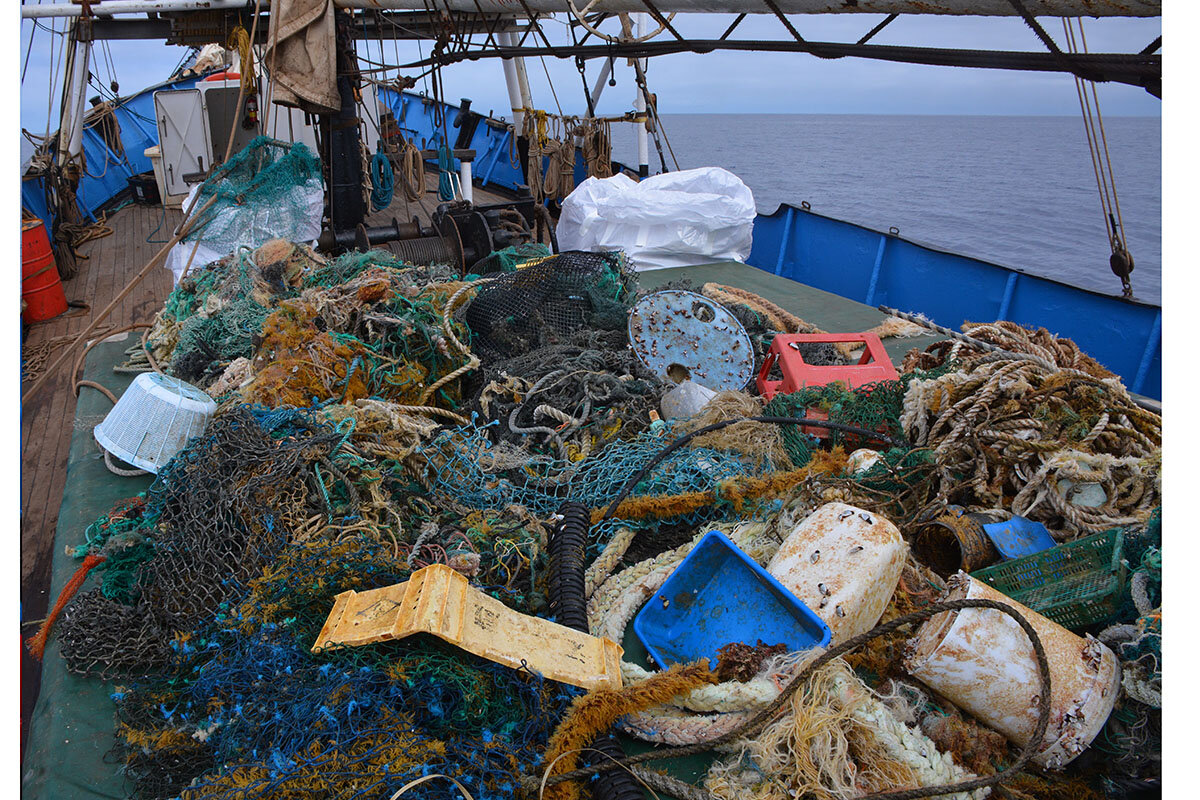Untangling the ocean trash glut, one ‘ghost net’ at a time
Loading...
Nothing pleases Mary Crowley more than to see a huge, dripping, bedraggled fishing net, ensnarled with plastic garbage, being lifted from the sea.
That is progress, she says.
Ms. Crowley, a sailor since childhood days spent in her grandfather’s wooden sailboat on Lake Michigan, has been working for more than a decade to clean up the world’s oceans. She started by urging fishermen to pick up floating plastic. Now her million-dollar effort employs drones, satellites, floating GPS buoys, sophisticated oceanographic models, a corps of yachtsmen, and an oceangoing cargo ship.
Why We Wrote This
When a problem seems insurmountable – like the millions of tons of plastic choking oceans – it’s easy to accept the status quo. It takes vision, tenacity, and ingenuity, which Mary Crowley has in spades, to fight back.
The Kwai, a 140-foot, two-masted cargo sailing vessel that normally shuttles supplies among Pacific islands, has been plucking nets and trash from the Pacific for the past six weeks. It is expected to return to Hawaii around June 23 with 100 tons of debris, the first of what Ms. Crowley hopes will be two such voyages this summer; she is hoping to dispatch the ship for a second voyage in July.
Much of that trash will be “ghost nets,” fishing nets abandoned or lost that float freely, ensnarling fish, marine life, trash, and passing vessels.
The Kwai’s crew of 11, sailors accustomed to unloading anything from cars to concrete on isolated islands, uses winches and sweat to hoist the heavy nets from the Great Pacific Garbage Patch, where swirling currents gather floating debris.
The term is misleading; the area is huge and the debris is spread out. But the Kwai is led to wayward nets in part by GPS buoys that yachtsmen and other sailors, volunteers for Ms. Crowley, have stopped mid-ocean to attach to trash.
“This work feels great,” Capt. Brad Ives replies mid-voyage from the Kwai by email. “When the weather is good and the nets are flowing, there is no better work for a fine old sailing ship. Crew spirits are high and we are cleaning our Mother Ocean.”
Researchers working with the project are experimenting with spotting large plastic debris from satellites – “We had quite a breakthrough,” Ms. Crowley says. She and colleagues are consulting a NASA-funded science team. They are working with researchers to further study currents using data from drifting sensors deployed, in part, by the Kwai.
And they are using more time-worn tactics to find trash.
“Everybody has their hunches,” Ms. Crowley says before flying from California to Hawaii to begin a two-week quarantine to greet the ship. “The captain talked to a boat that got entangled twice in one area. He thinks it will be good to look there.”
A labor of love for the sea
Ms. Crowley began her project as a labor of love for the sea. She runs a yacht chartering business from Sausalito, California. But her clients consistently confirmed her own observations that the ocean seems increasingly cluttered with plastic debris.
“It’s really quite shocking what a terrible issue this has become globally,” she says.
Scientists have sought to quantify the problem and its effects on the ecosystem. Every year, an estimated 8 million tons of plastic is washed from the lands and is threatening to choke the seas. The United Nations has warned that by 2050 there will be more plastic than fish in the sea. Marine mammals are routinely found dead, their bodies clogged with plastics. Microplastics – the result of deteriorating larger pieces or small manufactured beads – are now thoroughly infused in the marine food chain.
“Everyone in the world is gradually learning the amount of whales and dolphins and sea turtles and fish that get killed by ingesting plastic and by getting caught by plastic,” Ms. Crowley says.
There are many creative ideas to clean the ocean, and Ms. Crowley supports them all. She formed Ocean Voyages Institute in 1979 to educate audiences about the sea. Over time she gathered a “think tank” of sailors, naval architects, marine engineers, and fishermen. “We decided that one of the most harmful things going on in the ocean is the huge proliferation of large plastics,” she says. “This includes derelict fishing gear, and boats and piers and car fenders.”
When the Monitor first spoke with Ms. Crowley in 2010, she was recruiting independent fishermen to use their boats to haul garbage back to land. Since then, she has realized she needs bigger equipment. Last year, the nonprofit raised the funds to commission the Kwai for 25-day voyage. It returned with 42 tons of garbage, including several multiton nets.
This year, she is hoping to collect 100 tons on the first of two voyages for the Kwai, which left Hawaii May 4, accompanied by traditional chants and songs from crew members’ native cultures. After a stretch of weather that made the water choppy and debris hard to spot, the Kwai followed the GPS buoys into the garbage patch.
“There is debris practically every day inside the gyre,” Captain Ives writes from the ship. “The hunting is excellent now that visibility has improved.”
“The most difficult are always the big nets,” he reports by email. “These require divers in the water to get cargo slings around them and often several lifts to get them wrestled aboard. A large net can take several hours to wrestle aboard.”
Building a coalition to clean the ocean
Working with the Ocean Voyages Institute is a team of researchers. Nikolai Maximenko, a senior researcher at the University of Hawaii, heads the NASA-sponsored FloatEco project, and has used data from drifting sensors to create elaborate maps predicting the behavior of debris.
Dr. Maximenko accurately predicted the path of debris to both North America and Hawaii from the 2011 tsunami in Japan. He has helped plot how some of that debris becomes waylaid in the North Pacific Gyre.
Dr. Maximenko appreciates Ms. Crowley’s open-mindedness. “There are several approaches, and probably we need all of them,” he says.
Ms. Crowley welcomes scientific collaborators like Andrey Shcherbina, an oceanographer at the University of Washington in Seattle, who took advantage of the Kwai’s journey to deploy a special drift sensor in the middle of the garbage patch. “It was a perfect opportunity for us to hitch a ride to where the marine debris is,” he says of the ship’s project.
Ms. Crowley has recruited a cadre of volunteers with a gentle inexhaustibility.
“As someone who loves the ocean and has had the pleasure and honor of spending lots of time in the ocean,” she says, “it’s my responsibility to not have the health of our ocean held hostage by plastic garbage.”






